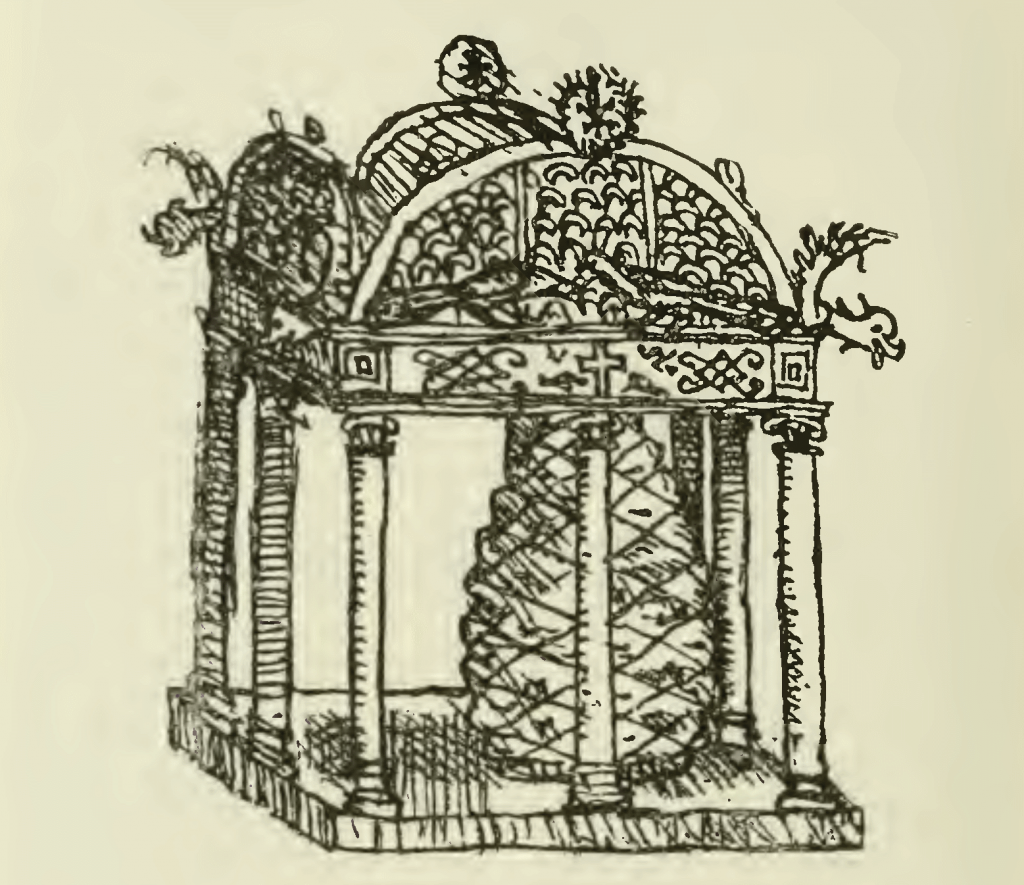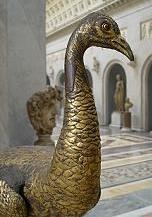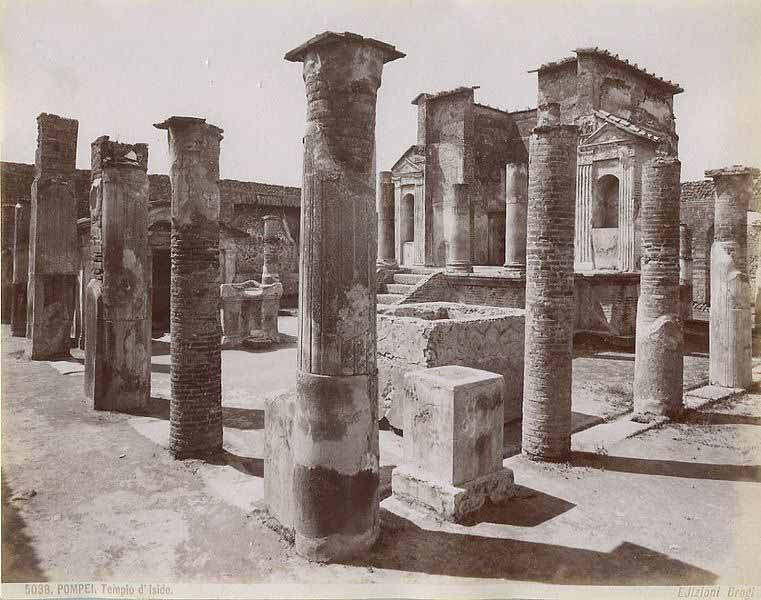Mirror: http://tinyurl.com/qz56u27
![]() Logo of the Rione.
Logo of the Rione.![]()
![]()
![Water installation with bronze pine-cone in the atrium of Old St Peter's, Rome. Drawing by Cronaca (1457-1505). Uffizi, Florence, 1572.]() Water installation with bronze pine-cone in the atrium of Old St Peter’s Basilica, Rome. Drawing by Cronaca (1457-1505). Uffizi, Florence, 1572.
Water installation with bronze pine-cone in the atrium of Old St Peter’s Basilica, Rome. Drawing by Cronaca (1457-1505). Uffizi, Florence, 1572.
![huelsen_fig3]()
![]()
![Quote Quote]() These pine-cones were a customary feature of the classic fountain, as the scales of the cone present natural and graceful outlets for the falling water. Symmachus’s fountain was one of the beauties of Rome in the days when the great Gothic King Theodoric ruled and loved the city. Three hundred years later it captivated the fancy of Charlemagne, crowned Emperor in St. Peter’s on Christmas Day, 800; and the fountain afterward erected before his great cathedral at Aix [now Aachen Cathedral] is ornamented with a huge pine-cone like the one which he and his Franks had seen in the exquisite fountain of St. Peter’s.
These pine-cones were a customary feature of the classic fountain, as the scales of the cone present natural and graceful outlets for the falling water. Symmachus’s fountain was one of the beauties of Rome in the days when the great Gothic King Theodoric ruled and loved the city. Three hundred years later it captivated the fancy of Charlemagne, crowned Emperor in St. Peter’s on Christmas Day, 800; and the fountain afterward erected before his great cathedral at Aix [now Aachen Cathedral] is ornamented with a huge pine-cone like the one which he and his Franks had seen in the exquisite fountain of St. Peter’s.
http://www.garden-fountains.us/fount...rs-fountain/5/
![hellenismo: bronze peacock from Hadrian’s Mausoleum, now in the Vatican Museum…]()
![]()
![]()
![]() Map of the archaeological complex: Largo di Torre Argentina, Rome, Italy
Map of the archaeological complex: Largo di Torre Argentina, Rome, Italy
![]()
![]()
![]()
![File:Temple de Serapis.JPG]()
![]()
![Temple of Serapis]() This temple was built for the Egyptian merchants. It was located on the Commercial Agora near the western gate. There is also another entrance into the temple from the south-west corner of the Agora through stairs.
This temple was built for the Egyptian merchants. It was located on the Commercial Agora near the western gate. There is also another entrance into the temple from the south-west corner of the Agora through stairs.![Artemis Temple]()
The original pine cone. Pigna (Fir cone) is the name of the quarter of Rome where this bronze sculpture was found; it was part of a fountain and it spouted water from holes on its top. It was probably placed in front of a Temple to Isis in Iseo Campense; the gilded peacocks decorated one of the entrances to Hadrian's Mausoleum. The Egyptian lions were added by Pope Gregory XVI; they came from Mostra dell'Acqua Felice and were replaced by copies. http://www.romeartlover.it/Vasi181.html
![]()
It was at Campus Martius prior to it being moved to the Court of the Pigna.
![]() glyph-type symbols below the animal (Courtyard of the Pinecone)
glyph-type symbols below the animal (Courtyard of the Pinecone)
One version of the pine-cone origins: "Publius Cincius Slavius, whose name appears on the base of the sculpture, built the Pine Cone statue that now resides in the Court of the Pine Cone (Cortile della Pigna) in the Vatican, in the 1st century AD. The piece was originally a fountain that resided in the Temple of Isis in Campo Martius next to the Pantheon. The site of the Temple of Isis is now occupied by the Biblioteca Casanatense but the area is still to this day called Pigna. The fountain is described as having water gushing from the holes in the scales of the cone similar to the Meta Sudans (the sweating rock that was also topped by a pine cone according to some) that still stands outside the Coliseum. The Pine Cone was then moved to the hall of St Peter’s Basilica in the 8th century in the time of Popes John VI, John VII or Zachary (Pope Zachary seems the most likely as he did more than the other two to “Christianize” Rome by building churches over the old Roman temples). One of them moved the Pine Cone from the Temple of Isis to St Peter’s Basilica (the original built by Constantine the Great) where it was covered by a baldachin (it is recreated in this state in the game Assassin’s Creed: Brotherhood where it houses a Piece of Eden). In 1608, when St Peters was being enlarged to its present form the Pine Cone was moved to its current location by Pope Paul V...The bronze peacocks, however, were not part of the original sculpture but are thought to be originally taken from Hadrian’s mausoleum (now Rome’s fortress, the Castel St. Angelo)." http://thedailybeagle.net/2013/09/08/the-pigna-and-the-apollo-belvedere-two-treasures-of-the-vatican/
Another version of the pine cone origins:
[quote]The Huge statue known as the Pigna (pine) or the Fontana Della Pigna depicts a giant Pine Cone. It is located in St. Peter's, in an area called the court of the Pigna.The Court of the Pigna is the northern part of the grand renaissance Belvedere Courtyard that stretches between the Papal Palaces to the "palazzetto" which belonged to Innocent VII's . The courtyard was segmented into three parts after the construction of Sixtus V's Library and the Braccio Nuovo of Pius VII. The present courtyard derived its name form the beautiful pine cone statue set into the "nicchone", borders on the south side with the Braccio Nuovo, and on the east it borders with the Chiaromonti Gallery. To its north you can find Innocent VIII's Palazzetto and on the west the galleries of the Apostolic Library are located.
The pine cone was cast out of bronze in the 1st or 2nd century by the sculptor Publius Cincius Slavius. He was identified as its creator because his name was written on the base of the huge pine. The Statue's height is almost 4 meters and on both sides of the pine cone there are bronze peacocks which are copies of the ones in Hadrian's tomb.
Before it was moved to its current location, known as the Court of the Pigna, the statue of the Pine was situated in the Campus Martius. This area is still known today as "Pigna" after this statue. At its previous location it was used as a fountain with the water pouring from holes pierced in the scales of the cone. At the 8th century it was transferred to the entrance hall of the medieval basilica of St. Peter. It was placed decoratively in the middle of the fountain covered by ornate baldachin. We know this because the statue was identified in Renaissance drawings of the hall. Eventually, during the construction of the current basilica, in 1608, the giant pine cone fountain was moved and situated in its current location.
This statue is a beautiful and ancient one and it's definitely worth stopping by and admiring it as it has been part of Rome's landscape for almost 2000 years! [unquote]
http://vatican.com/photos/gallery/court_of_the_pigna-p45
![]() Technical information
Technical information
Blessing genius Neo-Assyrian period, circa 721-705 BCE (reign of Sargon II)
Third gate of the palace of Sargon II, Khorsabad (ancient Dur-Sharrukin), Iraq
Bas-relief of gypseous alabaster
H. 4.09 m; L. 2.36 m; D. 0.75 m
Victor Place excavations, 1852-54
AO 19863
Near Eastern Antiquities [see: Musée du Louvre]
Blessing genius
Protective genii are supernatural beings who watch over humans or buildings and ward off evil spirits. This winged genius, along with one directly opposite, guarded the gates of the city of Khorsabad. It blessed all those who passed by it with water sprinkled from a pine cone.
Description
A protective and blessing genius
The site of Khorsabad (called Dur-Sharrukin in antiquity), which was excavated between 1843 and 1854 by Paul-Emile Botta and Victor Place, yielded orthostats, carved slabs of stone that protected and adorned the bases of brick walls. This monumental winged genius, represented frontally, was placed in the inner passage of one of the city gates. Another genius was located directly opposite. Both stood immediately behind the pair of winged bulls with human heads that guarded the gate. Like other genii placed at certain entrances to the palace, this one has a protective role. However it also performed a blessing function: from the pine cone, which could be shaken, liquid drawn from a little bucket was sprinkled over the passageway and those who passed along it.
A monumental sculpture
This colossal figure carved in high relief depicts a winged, bearded genius, shown frontally as far as the waist and in profile below. He holds a pine cone in his right hand and a small metal vessel (or situla) in his left hand. The face, framed by a curly beard, is surmounted by a tiara adorned with two pairs of horns. Over the figure's short tunic is a fringed cape, which covers the right shoulder and left leg. Two pairs of wings emerge from the back and spread symmetrically on either side of the body. His arms and forearms are adorned with rings and bracelets. He wears sandals, which cover his heels. On the base of this sculpture is a game of tick-tack-toe, scratched into it in ancient times, probably by sentries passing the time while on duty at the gate.
Genii: between the human and the divine?
Genii, depicted as bulls with human heads, men with birds' heads, and winged men, figure prominently in Assyrian mythology. They are creatures endowed with powers superior to those of human beings, yet they are not great deities, although they are sometimes represented with some of their attributes, for example, the horned tiara here. These supernatural beings had the power to ward off evil spirits. The genius seen here had an essentially protective role: it defended the gates and walls of the city. However, it was also a blessing genius, which held holy water and sprinkled it on visitors with a pine cone. Genii are often depicted in Assyrian art, especially in ceremonial scenes where they are shown pollinating the sacred palm tree. [see: Mesopotamia | Louvre Museum]
http://www.geocities.ws/leinad.trotta/prophecies.html
![]()
![]()
Somnathpur, Halebid. Lakshmi. Divinity of wealth holding maize cob or pine-cone.
Hieroglyphs: kandə ʻpineʼ, ‘ear of maize’. Rebus: kaṇḍa ‘tools, pots and pans of metal’. Rebus: kāḍ ‘stone’. Ga. (Oll.) kanḍ, (S.) kanḍu (pl. kanḍkil) stone (DEDR 1298).
![]() Halebid."Maize breeders in India, China, United States, and Great Britain, who have seen extensive collections of the illustrations, concur...only sculptors with abundant ears of maize as models could have created these illustrations of maize"(Click to enlarge). Photo by Carl L. Johannessen.
Halebid."Maize breeders in India, China, United States, and Great Britain, who have seen extensive collections of the illustrations, concur...only sculptors with abundant ears of maize as models could have created these illustrations of maize"(Click to enlarge). Photo by Carl L. Johannessen.
![]()
Hieroglyphs: kandə ʻpineʼ, ‘ear of maize’. Rebus: kaṇḍa ‘tools, pots and pans of metal’. Rebus: kāḍ ‘stone’. Ga. (Oll.) kanḍ, (S.) kanḍu (pl. kanḍkil) stone (DEDR 1298).
![]() Allograph: Kur. kaṇḍō a stool. Malt. kanḍo stool, seat. (DEDR 1179). Rebus:Tu. kandůka, kandaka ditch, trench. Te. kandakamu id. Konḍa kanda trench made as a fireplace during weddings. Pe. kanda fire trench. Kui kanda small trench for fireplace. Malt. kandri a pit. (DEDR 1214).
Allograph: Kur. kaṇḍō a stool. Malt. kanḍo stool, seat. (DEDR 1179). Rebus:Tu. kandůka, kandaka ditch, trench. Te. kandakamu id. Konḍa kanda trench made as a fireplace during weddings. Pe. kanda fire trench. Kui kanda small trench for fireplace. Malt. kandri a pit. (DEDR 1214).
![]() Pine cone glyphs adorn the side stools and is atop the ‘altars’ or ‘standards’. [quote]Description: The 'Garden Party' relief from the North Palace of Ashurbanipal at Nineveh. This carved stone picture hides a gory secret. King Ashurbanipal and his Queen are enjoying a party in their garden. Can you see the Queen sitting down facing her husband? A harpist on the left plays music while they eat and drink. But in the tree beside him is the severed head of King Teumann, a local ruler who had tried to fight against Ashurbanipal. The picture was on the wall in the royal palace, to warn any visitors not to try the same thing. It should also be noted that depictions of women are rare in Assyrian art. (Source: British Museum website) Date: c.645 BCE [unquote]
Pine cone glyphs adorn the side stools and is atop the ‘altars’ or ‘standards’. [quote]Description: The 'Garden Party' relief from the North Palace of Ashurbanipal at Nineveh. This carved stone picture hides a gory secret. King Ashurbanipal and his Queen are enjoying a party in their garden. Can you see the Queen sitting down facing her husband? A harpist on the left plays music while they eat and drink. But in the tree beside him is the severed head of King Teumann, a local ruler who had tried to fight against Ashurbanipal. The picture was on the wall in the royal palace, to warn any visitors not to try the same thing. It should also be noted that depictions of women are rare in Assyrian art. (Source: British Museum website) Date: c.645 BCE [unquote]![marduk pine cone, pine cone symbolism, pine pollen powder, pine pollen benefits]() Marduk, winged, holding the pine-cone. Bracelet has safflower hieroglyph. Annunaki, Sumerian.
Marduk, winged, holding the pine-cone. Bracelet has safflower hieroglyph. Annunaki, Sumerian.
![annunaki pine cone, pine cone symbolism, pine pollen powder, pine tree pollen, pine pollen benefits]() Pine cones helod by eagle-divinities flanking tree of life. The divinities also hold wallets.
Pine cones helod by eagle-divinities flanking tree of life. The divinities also hold wallets.
Masonic cadueceus with pine cone.
![pine cone staff of osiris, pine cone symbolism, occult pine cones, pine pollen benefits, pine pollen powder]() A pair of eagle-headed Annunak flanking a staff capped with a pine-cone.
A pair of eagle-headed Annunak flanking a staff capped with a pine-cone.
The monumental bronze pine cone, eleven feet high, is an archaeo-metallurgical marvel. So are the two bronze peacocks which are shown together with the pine-cone on the atrium of Old St Peter’s Basilica of 15th century CE. The history of the two types of artifacts: 1. bronze pine-cone and 2. pair of gilt bronze peacocks which date back to the ca. 100 BCE with links to the Temples of Isis and Serapis in the Egyptian tradition held sacred in from 2nd century BCE in Rome, Italy and from ca. 100 BCE in Pompeii.
Both are hierolyphs denoting the advances in archaeometallurgy and are deployed using rebus-metonymy layered cipher to denote Meluhha metalwork catalogues. It is reasonable to infer that both the artifacts (pine-cone and peacock) were made using cire perdue (lost-wax) method of castings of copper PLUS alloying minerals which resulted in hard metal alloy castings. Further metallurgical analyses on these artifacts of Vatican will provide additional evidence to validate this hypothesis.
It is an earnest plea to Vatican to provide access to these artifacts to archaeometallurgists for evaluation.
1. Hieroglyph, signifier: kandə 'pine cone' Rebus, signified metalwork: khaṇḍa. A portion of the front hall, in a temple; kaṇḍ'fire-altar' (Santali) kāṇḍa 'tools, pots and pans and metal-ware' (Marathi)
2. Hieroglyph, signifier: mora, 'peacock' Rebus signified metalwork: morakkhaka loha, 'a kind of copper'; moraka'a kind of steel'.
mora peacock; morā ‘peafowl’ (Hindi); rebus: morakkhaka loha, a kind of copper, grouped with pisācaloha (Pali). [Perhaps an intimation of the color of the metal produced which shines like a peacock blue feather.] moraka "a kind of steel" (Samskritam)
The two peacocks are cast in bronze and covered with a thin layer of gold plate. Peacocks Cat. 5117, 5120 Early medieval sources record the presence of these peacocks in the area around Hadrian's Mausoleum (117-138 A.D.), known today as Castel Sant'Angelo. These gilded bronze birds were for a long time part of the decoration of the great cloister in front of the old basilica of St Peter, ornamenting the so-called Cantaro.It was a fountain in which pilgrims could wash themselves formed of the great bronze pine cone which now forms the focal point of the Cortile della Pigna in the Vatican Museums. In 1608, during the building of the new basilica of St Peter, the peacocks were also moved to the Cortile della Pigna, and later brought here to where they are now kept to ensure their preservation. The peacocks are notable for their extremely fine workmanship which can be seen in the realistic details and the refined representation of their plumage. These characteristics, together with the symbolism of the peacock as representing immortality, reinforce the theory that these birds were indeed part of the original decoration of Hadrian's Mausoleum.
Hieroglyphs of Pine Cone and Peacocks and myth-making in the Vatican
The pine-cone and peacock sculptures in bronze in the Vatican are a memorial for the departed ancestors. There ain’t no need to indulge in mythological excursus to explain the vividly pictorial memorial which is traced to the days of the Temple of Isis.
The thesis is that the peacock, as a hieroglyph, is associated with funerary events in Indus-Sarasvati (Meluhha) civilization and contact areas in Ancient Near East. The presence of pine-cone and peacocks in the context of mausoleums of ancient Rome can be explained within the Meluhha hieroglyphic framework and related to sacredness associated with remembrance of the departed ancestors. The presence of cinnamon ca 10th century BCE in Israel reinforces the presence of traders who had contacts with Meluhha
Peacock as a Meluhha hieroglyph
Hieroglyph pine-cone is kandə Rebus: khaṇḍa. A portion of the front hall, in a temple Hieroglyph peacock is maraka 'Rebus: maraca ‘death’, māraka ‘god of death’; smāraka, 'memorial for ancestors'. ' smará ʻ remembrance ʼ(CDIAL 13861).
In Pali (Rhys Davids' lexicon), jīvan-jīvaka (poss. onomatopoetic) means a bird, a sort of pheasant which utters a note sounding like jīvanjīva (Di_gha III.201)... Also cited is a Jain phrase: jīvanjīveṇa gacchai jīvanjīvenan ciṭṭhai [Weber Bhagavati_ pp. 289,290 with doubtful interpretation "living he goes with life"? or "he goes like the j. bird"?]
The Munda word for peacock marak/mara "cryer, peacock", later Sanskrit māra (and Pali etc) 'death, God Death', the Munda peacock symbol = death, and the Cemetery H peacock pictures on urns with cremated bodies. Peacock and heaven (marak = peacock; merxā_ = sky, heaven ?may the soul go to heaven)
Parji. marp- (mart-)= to lighten; Kurux. merxā_ = sky, heaven; Malto. mergu = sky, heaven; see Te.merūmu = flash of lightning.
Large burial urn. Late Harappan Period large burial urn with ledged rim for holding a bowl-shaped lid. The painted panel around the shoulder of the vessel depicts flying peacocks with sun or star motifs and wavy lines that may represent water. Cemetery H period, after 1900 BC. These new pottery styles seem to have been introduced at the very end of the Harappan Period. The transitional phase (Period 4) at Harappa has begun to yield richly diverse material remains suggesting a period of considerable dynamism as socio-cultural traditions became realigned.
Dish or lid. Late Harappan Period dish or lid with perforation at edge for hanging or attaching to large jar. It shows a Blackbuck antelope with trefoil design made of combined circle-and-dot motifs, possibly representing stars. It is associated with burial pottery of the Cemetery H period, dating after 1900 BC.
The Late Harappan Period at Harappa is represented by the Cemetery H culture (190-1300 BC) which is named after the discovery of a large cemetery filled with painted burial urns and some extended inhumations. The earlier burials in this cemetery were laid out much like Harappan coffin burials, but in the later burials, adults were cremated and the bones placed in large urns (164). The change in burial customs represents a major shift in religion and can also be correlated to important changes in economic and political organization. Cemetery H pottery and related ceramics have been found throughout northern Pakistan, even as far north as Swat, where they mix with distinctive local traditions. In the east, numerous sites in the Ganga-Yamuna Doab provide evidence for the gradual expansion of settlements into this heavily forested region. One impetus for this expansion may have been the increasing use of rice and other summer (kharif) crops that could be grown using monsoon stimulated rains. Until late in the Harappan Period (after 2200 BC) the agricultural foundation of the Harappan cities was largely winter (rabi) crops that included wheat and barley. Although the Cemetery H culture encompassed a relatively large area, the trade connections with the western highlands began to break down as did the trade with the coast. Lapis lazuli and turquoise beads are rarely found in the settlements, and marine shell for ornaments and ritual objects gradually disappeared. On the other hand the technology of faience manufacture becomes more refined, possibly in order to compensate for the lack of raw materials such as shell, faience and possibly even carnelian.
http://www.harappa.com/indus2/index.html Slides162, 164
Pine-cone as a Meluhha hieroglyph
Sgh. kaḍol mangrove. Ash. piċ -- kandə ʻ pine ʼ, Kt. pṳ̄ċi, piċi, Wg. puċ, püċ (pṳ̄ċ -- kəŕ ʻ pine -- cone ʼ), Pr. wyoċ, Shum. lyēwič (lyē -- ?).(CDIAL 8407). Cf. Gk. peu/kh f. ʻ pine ʼ, Lith. pušìs, OPruss. peuse NTS xiii 229. The suffix –kande in the lexeme: Ash. piċ-- kandə ʻ pine ʼ may be cognate with the bulbous glyphic related to a mangrove root: Koḍ. kaṇḍe root-stock from which small roots grow; ila·ti kaṇḍe sweet potato (ila·ti England). Tu. kaṇḍe, gaḍḍè a bulbous root; Ta. kaṇṭal mangrove, Rhizophora mucronata; dichotomous mangrove, Kandelia rheedii. Ma. kaṇṭa bulbous root as of lotus, plantain; point where branches and bunches grow out of the stem of a palm; kaṇṭal what is bulb-like, half-ripe jackfruit and other green fruits; R. candel. (DEDR 1171). Rebus: kaṇḍa ‘tools, pots and pans of metal’. kanda m. ʻ bulbous root ʼ MBh., n. ʻ garlic ʼ lex. [Prob. with gaṇḍa -- 1 ← Drav. T. Burrow BSOAS xii 369 and EWA i 152 with lit.] Pa. kanda -- m. ʻ bulb, bulbous root ʼ; Pk. kaṁda -- m. ʻ bulbous root ʼ, °dī -- f. ʻ radish ʼ; Or. kandā ʻ edible bulbous root; OMth. kã̄da ʻ bulb ʼ(CDIAL 2723).
Myths in Vatican to invent explanations for the pine-cone and peacocks and the context of Temples for Isis
Jenny Uglow has rendered a remarkable historical account. (Uglow, Jenny, 2012, The Pinecone, Faber & Faber). The book narrates the story of the builder Sarah Losh of the magical church in Wreay, near Carlisle, Victorian England. She was heiress to an industrial fortune. Everywhere in this church are pinecones, her signature in stone, making the church a rendering of the power of myth ‘and the great natural cycles of life and death and rebirth’. The book provides Sarah’s travel to Rome: “Death, as well as beauty, marched the streets. And the processions were matched by the panoply of symbols, on ancient columns and new buildings, in temples and market squares. Among these were plenty of pinecones: the Pope carried a carved cone on his staff; a pinecone fountain stood outside the old church of St Mrco, and the largest cone in the world, flanked by two peacocks, was found at the Vatican. This was the only original Roman fountain remaining in Rome, the Fontana della Pigna, dating from the first century AD, which had once stood next to the Temple of Isis in the Forum, spouting water from the top.”
...
Isis was worshipped in the entire Greco-Roman world.
The Temple of Isis in Pompeii. The cult of Isis is said to have arrived in Pompeii ca. 100 BCE. (Nappo, Salvatore. "Pompey: Guide to the Lost City", White Star, 2000, p.89) “Its role as a Hellenized Egyptian temple in a Roman colony was fully confirmed with an inscription detaled by Francisco la Vega on July 20, 1765.” This was the second structure. Original structure under Augustan was damaged in an earthquake of 62 CE.
Pigna is the name of rione IX of Rome. "Pigna ("pine-cone") refers to a famous bronze sculpture of Roman origin, in the shape of a huge pine-cone. It likely acted as a fountain in the Baths of Agrippa, the first establishment of this kind opened in Rome (late 1st century BC), at the back of the Pantheon's site."
 Logo of the Rione.
Logo of the Rione."Pigna. There used to be a tradition, wholly unfounded, but deeply rooted in the Roman mind, to the effect that the great bronze pine-cone, eleven feet high, which stands in one of the courts of the Vatican, giving it the name c Garden of the Pine-cone,’ was originally a sort of stopper which closed the round aperture in the roof of the Pantheon. The Pantheon stands at one cornerof the Region of Pigna, and a connection between the Region, the Pantheon, and the Pine-cone seems vaguely possible, though altogether unsatisfactory. The truth about the Pine-cone is perfectly well known; it was part of a fountain in Agrippa’s artificial lake in the Campus Martius, of which Pigna was a part, and it was set up in the cloistered garden of Saint Peter’s by Pope Symmachus about fourteen hundred years ago. The lake may have been near the Pantheon." (Crawford, Francis Marion, Ave Roma Immortals, 1898, London, Macmillan & Co. Ltd., p.345)
"Composed of a large bronze pine cone almost four meters high which once spouted water from the top, the Pigna originally stood near the Pantheon next to the Temple of Isis. It was moved to the courtyard of the old St. Peter's Basilica during the Middle Ages and then moved again, in 1608, to its present location." -- Official history on the Vatican website.
The bronze peacocks on either side of the fountain are copies of those decorating the tomb of the Emperor Hadrian, now the Castel Sant' Angelo. http://en.wikipedia.org/wiki/Fontana_della_Pigna. The peacocks decorated the Mausoleum or the tomb of Hadrian erected between 134 and 139 CE. Copies of “Bronze peacocks” maybe from the Mausoleum of Hadrian. The originals are in the New Wing of the Chiaramonti Museum (Braccacio Museum)
Detail of the water holes on the bronze pine-cone.

Water holes on the pine-cone can be seen.
Thanks to Roger-Pears who found online on February 16th, 2015, the following copy of a drawing of the fountain, itself taken from Huelsen. (A. van den Hoek & John H. Herrmann Jr, “Paulinus of Nola, courtyards and canthari: a second look”, In: A. van den Hoek &c, Pottery, Pavements, and Paradise: Iconographic and Textual Studies on Late Antiquity, Brill (2013), p.45, fig. 13; C. Huelsen, “Der Cantharus von Alt-St. -Peter und die antiken Pignen-
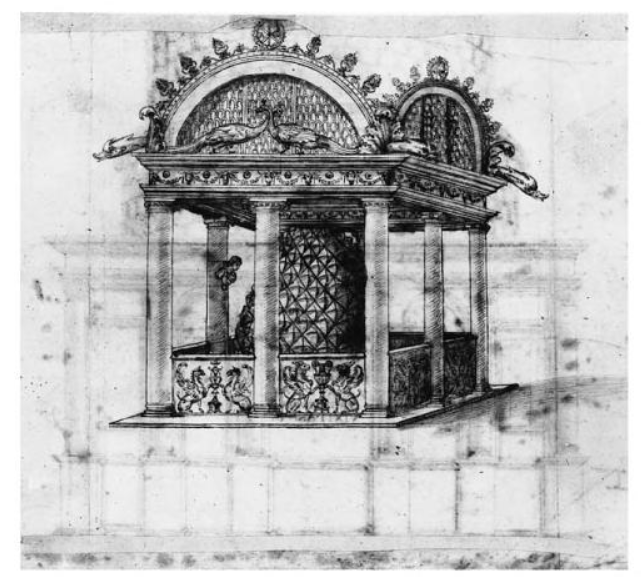 Water installation with bronze pine-cone in the atrium of Old St Peter’s Basilica, Rome. Drawing by Cronaca (1457-1505). Uffizi, Florence, 1572.
Water installation with bronze pine-cone in the atrium of Old St Peter’s Basilica, Rome. Drawing by Cronaca (1457-1505). Uffizi, Florence, 1572.Further drawings in Heulsen article:

Andrea della Vaccaria, “Ornamenti di fabriche antichi e moderni dell’alma citta di Roma”, 1600, quarto.
Another image from a manuscript, Ms. Brussels 17872, fol. 56v, by Philipp de Winghe, and made around 1591-2.
Drawing of St.Peter's fountain by
Francisco de Hollanda (early 1500s)
St. Peter's fountain, in a pen drawing by anonymous (c. 1525) "Medieval chronicles such as the famous Mirabilia Urbis Romae (12th century) mentioned St. Peter's fountain among the city's noticeable features. The water gushed from hundreds of tiny holes on its surface...Scarce Renaissance drawings feature the fountain standing in the center of a square basin, covered by a canopy that rested over eight columns (originally they were four) and richly decorated with marbles of various types; in particular on its top parts were bronze peacocks; maybe from the mausoleum of Hadrian, which in the description provided by the chronicle are referred to as 'griffons' covered with a gold leaf...When St. Peter's was completely rebuilt (1506-1614), the fountain and the canopy were dismantled, and most of the precious materials were reused for other purposes. The only parts spared were the peacocks and the pine-cone, which around 1565 Pirro Ligorio set in the large niche of the Courtyard of Belvedere,, later renamed of the Pine-cone. The peacocks now on display in the courtyard are copies; the original ones, which still shine as gold (as the old chronicle says), are kept indoors, in the Braccio Nuovo (new wing) of the Chiaramonti Museum (Vatican Museums)." http://roma.andreapollett.com/S3/roma-ft1b.htm
http://www.garden-fountains.us/fount...rs-fountain/5/
One of the original bronze peacocks.

One of the original peacocks now in Braccacio Museum. Two bronze peacocks are from Hadrian’s Mausoleum (tomb).


Bronze peacocks lent by Vatican to be shown in British Museum. http://www.standard.co.uk/arts/walltowall-hadrian-7408277.html
The present Pigna in the Vatican seems to be a left-over from the original Basilica of St. Peter. The left-over may be two bronze artifacts: 1. bronze pine-cone in original; 2. replicas of two bronze peacocks originals of which ar kept in Braccacio Nuovo Museum. The question is: how did the two bronze artifacts, the pine-cone and the pair of peacocks get lodged in St. Peter's Basilica. Some answers and some conjectures are discussed.
[quote]“Bronze Pine Cone” signed Publius Cincius Salvio from the area of the Baths of Agrippa, maybe fountain in the Temple of Isis (Note: Possible location discussed in Annex A).
It was eventually placed in the atrium of the old Basilica of St. Peter.
It gave the name to the central neighborhood called Rione Pigna, where the Temple of Isis was originally located. [unquote]
One surmise is that the pinecone acted as a fountain in the Baths of Agrippa dated to 1st century BCE.
http://roma.andreapollett.com/S5/rione09.htm
http://roma.andreapollett.com/S5/rione09.htm
The surmise is based on the following evidence:
 Map of the archaeological complex: Largo di Torre Argentina, Rome, Italy
Map of the archaeological complex: Largo di Torre Argentina, Rome, ItalyThis complex had 4 temples dated to A) 3rd cent BCE (Temple of Juturna), B) 101 BCE (Fortuna Huiusce Diei), C) 4th or 3rd cent. (Feronia), D) 2nd cent. BCE (Lares Permarini) devoted to various divinities revered by Gaius Lutalius Catulus, Quintus Lutalius Catulus . Further excavations may perhaps explain the reason for the fountain with the pine-cone surrounded by 4 sivalingas. In Meluhha archaeometallurgical tradition, the sivalingas were stambhas or pillars of light/fire used as ekamukha linga in smelter structures and metalwork areas (as shown in Bhuteshwar relief).
Temple: खंडेराव [ khaṇḍērāva ] m (खंड Sword, and राव) An incarnation of Shiva. Popularly खंडेराव is but dimly distinguished from भैरव. खंडोबा [ khaṇḍōbā ] m A familiar appellation of the god खंडेराव. खंडोबाचा कुत्रा [ khaṇḍōbācā kutrā ] m (Dog of खंडोबा. From his being devoted to the temple.) A term for the वाघ्या or male devotee of खंडोबा.
Hieroglyph: खंडोबाची काठी [ khaṇḍōbācī kāṭhī ] f The pole of खंडोबा. It belongs to the temples of this god, is taken and presented, in pilgrimages, at the visited shrines, is carried about in processions &c. It is covered with cloth (red and blue), and has a plume (generally from the peacock's tail) waving from its top.
The cultural link of metalwork with Rudra-Siva iconically denoted by 1) orthographic variants of linga, 2) ekamukhalinga evidences of Ancient Far East and 3) the presence of linga in the context of a metal smelter in a Bhuteshwar artifact of 2nd cent. BCE is thus an area for further detailed investigation in archaeometallurgy and historical linguistics of Indian Sprachbund.

Architectural fragment with relief showing winged dwarfs (or gaNa) worshipping with flower garlands, Siva Linga. Bhuteshwar, ca. 2nd cent BCE. Lingam is on a platform with wall under a pipal tree encircled by railing. (Srivastava, AK, 1999, Catalogue of Saiva sculptures in Government Museum, Mathura: 47, GMM 52.3625) The tree is a phonetic determinant of the smelter indicated by the railing around the linga: kuṭa, °ṭi -- , °ṭha -- 3, °ṭhi -- m. ʻ tree ʼ Rebus: kuṭhi 'smelter'. kuṭa, °ṭi -- , °ṭha -- 3, °ṭhi -- m. ʻ tree ʼ lex., °ṭaka -- m. ʻ a kind of tree ʼ Kauś.Pk. kuḍa -- m. ʻ tree ʼ; Paš. lauṛ. kuṛāˊ ʻ tree ʼ, dar. kaṛék ʻ tree, oak ʼ ~ Par. kōṛ ʻ stick ʼ IIFL iii 3, 98. (CDIAL 3228).
Lingam, grey sandstone in situ, Harappa, Trench Ai, Mound F, Pl. X (c) (After Vats). "In an earthenware jar, No. 12414, recovered from Mound F, Trench IV, Square I... in this jar, six lingams were found along with some tiny pieces of shell, a unicorn seal, an oblong grey sandstone block with polished surface, five stone pestles, a stone palette, and a block of chalcedony..." (Vats,MS, Excavations at Harappa, p. 370)
Cylindrical clay steles of 10 to 15 cms height occur in ancient fire-altars (See report by BB Lal on Kalibangan excavations).
A number of polished stone pillars were found in Dholavira. (See April 2015 published Dholavira excavation report: http://asi.nic.in/pdf_data/dholavira_excavation_report_new.pdf
I suggest that these are hieroglyphs signifying pillars of light: tã̄bṛā, tambira (Prakritam) Rebus: tamba, 'copper' (Meluhha. Indian sprachbund)
See: three stumps on Sit Shamshi bronze. [kūpa -- 2, stambha -- ] G. kuvātham m. ʻ mast of a ship ʼ.(CDIAL 3403) *ṭhōmba -- . 1. G. ṭhobrũ ʻ ugly, clumsy ʼ.2. M. ṭhõb m. ʻ bare trunk, boor, childless man ʼ, thõbā m. ʻ boor, short stout stick ʼ (LM 340 < stambha -- ).(CDIAL 5514) Rebus: tamba, 'copper' (Meluhha. Indian sprachbund) Numeral three: kolmo 'three' Rebus: kolami 'smithy, forge'.
A pair of Skambha in Dholavira close to kole.l'smithy, temple' ( (8-shaped stone structure): Ko. kole·l smithy, temple in Kota village. To. kwala·l Kota smithy.(DEDR 2133).
Hieroglyph: tamba 'pillar'; tambu id. (Sindhi) Rebus: tamba, tã̄bṛā, tambira 'copper' (Prakritam) http://bharatkalyan97.blogspot.in/2015/05/smithy-is-temple-of-bronze-age-stambha_14.html

Fontana della Pigna(fountain of the pine cone) in piazza San Marco. This fountain, very close to theAltare della Patria, celebrates the huge bronze sculpture called Pignone(kept in the Vatican museums today).
The original statue, almost 4 meters tall, was found in middle ages in this area and gave the name to this neighborhood (rione della pigna). The Pignone was probably a decoration of the ancient roman temple of Isis and Serapis at campo Marzio.
http://www.romeinsiderguide.com/weird-fountains-in-rome.html
लोखंड ) Composed of iron; relating to iron लोहोलोखंड (p. 723) [ lōhōlōkhaṇḍa ] n (लोह & लोखंड ) Iron tools, vessels, or articles in general.
S. Kalyanaraman
Sarasvati Research Center
May 6, 2015
The hieroglyph membrum virile denoted rebus: copper, metal.
Hieroglyph: ``^penis'': So. laj(R) ~ lij ~ la'a'j ~ laJ/ laj ~ kaD `penis'.Sa. li'j `penis, esp. of small boys'.Sa. lO'j `penis'.Mu. lOe'j ~ lOGgE'j `penis'. ! lO'j Ho loe `penis'.Ku. la:j `penis'.@(C289)``^penis'':Sa. lOj `penis'. Mu. lOj `penis'.KW lOj @(M084)
Rebus: lo 'copper' lōhá ʻ red, copper -- coloured ʼ ŚrS., ʻ made of copper ʼ ŚBr., m.n. ʻ copper ʼ VS., ʻ iron ʼ MBh. [*rudh -- ] Pa. lōha -- m. ʻ metal, esp. copper or bronze ʼ; Pk. lōha -- m. ʻ iron ʼ, Gy. pal. li°, lihi, obl. elhás, as. loa JGLS new ser. ii 258; Wg. (Lumsden) "loa"ʻ steel ʼ; Kho. loh ʻ copper ʼ; S. lohu m. ʻ iron ʼ, L. lohā m., awāṇ. lōˋā, P. lohā m. (→ K.rām. ḍoḍ. lohā), WPah.bhad. lɔ̃un., bhal. lòtilde; n., pāḍ. jaun. lōh, paṅ. luhā, cur. cam. lohā, Ku. luwā, N. lohu, °hā, A. lo, B. lo, no, Or. lohā, luhā, Mth. loh, Bhoj. lohā, Aw.lakh. lōh, H. loh, lohā m., G. M. loh n.; Si. loho, lō ʻ metal, ore, iron ʼ; Md. ratu -- lō ʻ copper ʼ. WPah.kṭg. (kc.) lóɔ ʻ iron ʼ, J. lohā m., Garh. loho; Md. lō ʻ metal ʼ.(CDIAL 11158)kandə 'pine cone' Rebus, signified metalwork: khaṇḍa. A portion of the front hall, in a temple; kaṇḍ 'fire-altar' (Santali) kāṇḍa 'tools, pots and pans and metal-ware' (Marathi)
लोखंड (p. 723) [ lōkhaṇḍa ] n (लोह S) Iron लोखंडकाम (p. 723) [ lōkhaṇḍakāma ] n Iron work; that portion (of a building, machine &c.) which consists of iron. 2 The business of an ironsmith.
लोखंडी (p. 723) [ lōkhaṇḍī ] a (S. Kalyanaraman
Sarasvati Research Center
May 6, 2015
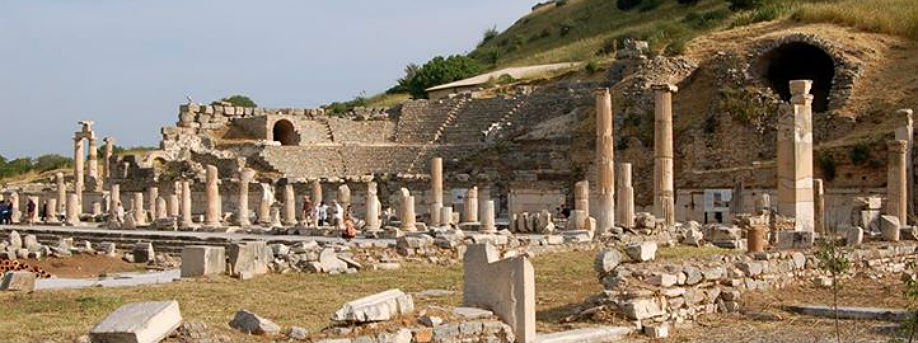

_-2.jpg)
Temple de Serapis
Temple of Serapis
 This temple was built for the Egyptian merchants. It was located on the Commercial Agora near the western gate. There is also another entrance into the temple from the south-west corner of the Agora through stairs.
This temple was built for the Egyptian merchants. It was located on the Commercial Agora near the western gate. There is also another entrance into the temple from the south-west corner of the Agora through stairs.
There are certain indications that suggest the temple was never finished fully. It is estimated that the construction of the temple was started in the 2nd century CE.
There is a statue found inside the temple made by using the Egyptian granite. Also some inscriptions found inside the temple indicate that the temple was constructed for those who believe in Serapis. In Ephesus Museum there is a monument on which the main Goddess of Ephesians, Artemis, and the principal god of Egypt, Serapis, take place together with garland as a symbol of peace.
It is well documented fact that Ephesus had a very strong commercial link with the influential port city of Egypt, Alexandria. During these ancient times Egypt was the biggest producer of wheat. They exchanged wheat with other commercial items from Ephesus and other Ionian cities.
It was converted to a church during the following Christian period. There are remains of a baptisterium in the eastern corner of the temple.
|

Pigna Vatican Museum Courtyard gilt bronze. Rome.
Originally a Roman fountain dating from 1st or 2nd century CE
The bronze pine cone (`Pigna`) at the Cortile della Pigna square. Peacocks from Hadrians Mausoleum (Castel Sant'Angelo) http://pictify.com/130116/pigna-vatican-museum-courtyard Pine cone at the Vatican, flanked by two peacocks.It was at Campus Martius prior to it being moved to the Court of the Pigna.
 glyph-type symbols below the animal (Courtyard of the Pinecone)
glyph-type symbols below the animal (Courtyard of the Pinecone)One version of the pine-cone origins: "Publius Cincius Slavius, whose name appears on the base of the sculpture, built the Pine Cone statue that now resides in the Court of the Pine Cone (Cortile della Pigna) in the Vatican, in the 1st century AD. The piece was originally a fountain that resided in the Temple of Isis in Campo Martius next to the Pantheon. The site of the Temple of Isis is now occupied by the Biblioteca Casanatense but the area is still to this day called Pigna. The fountain is described as having water gushing from the holes in the scales of the cone similar to the Meta Sudans (the sweating rock that was also topped by a pine cone according to some) that still stands outside the Coliseum. The Pine Cone was then moved to the hall of St Peter’s Basilica in the 8th century in the time of Popes John VI, John VII or Zachary (Pope Zachary seems the most likely as he did more than the other two to “Christianize” Rome by building churches over the old Roman temples). One of them moved the Pine Cone from the Temple of Isis to St Peter’s Basilica (the original built by Constantine the Great) where it was covered by a baldachin (it is recreated in this state in the game Assassin’s Creed: Brotherhood where it houses a Piece of Eden). In 1608, when St Peters was being enlarged to its present form the Pine Cone was moved to its current location by Pope Paul V...The bronze peacocks, however, were not part of the original sculpture but are thought to be originally taken from Hadrian’s mausoleum (now Rome’s fortress, the Castel St. Angelo)." http://thedailybeagle.net/2013/09/08/the-pigna-and-the-apollo-belvedere-two-treasures-of-the-vatican/
Another version of the pine cone origins:
[quote]The Huge statue known as the Pigna (pine) or the Fontana Della Pigna depicts a giant Pine Cone. It is located in St. Peter's, in an area called the court of the Pigna.The Court of the Pigna is the northern part of the grand renaissance Belvedere Courtyard that stretches between the Papal Palaces to the "palazzetto" which belonged to Innocent VII's . The courtyard was segmented into three parts after the construction of Sixtus V's Library and the Braccio Nuovo of Pius VII. The present courtyard derived its name form the beautiful pine cone statue set into the "nicchone", borders on the south side with the Braccio Nuovo, and on the east it borders with the Chiaromonti Gallery. To its north you can find Innocent VIII's Palazzetto and on the west the galleries of the Apostolic Library are located.
The pine cone was cast out of bronze in the 1st or 2nd century by the sculptor Publius Cincius Slavius. He was identified as its creator because his name was written on the base of the huge pine. The Statue's height is almost 4 meters and on both sides of the pine cone there are bronze peacocks which are copies of the ones in Hadrian's tomb.
Before it was moved to its current location, known as the Court of the Pigna, the statue of the Pine was situated in the Campus Martius. This area is still known today as "Pigna" after this statue. At its previous location it was used as a fountain with the water pouring from holes pierced in the scales of the cone. At the 8th century it was transferred to the entrance hall of the medieval basilica of St. Peter. It was placed decoratively in the middle of the fountain covered by ornate baldachin. We know this because the statue was identified in Renaissance drawings of the hall. Eventually, during the construction of the current basilica, in 1608, the giant pine cone fountain was moved and situated in its current location.
This statue is a beautiful and ancient one and it's definitely worth stopping by and admiring it as it has been part of Rome's landscape for almost 2000 years! [unquote]
http://vatican.com/photos/gallery/court_of_the_pigna-p45
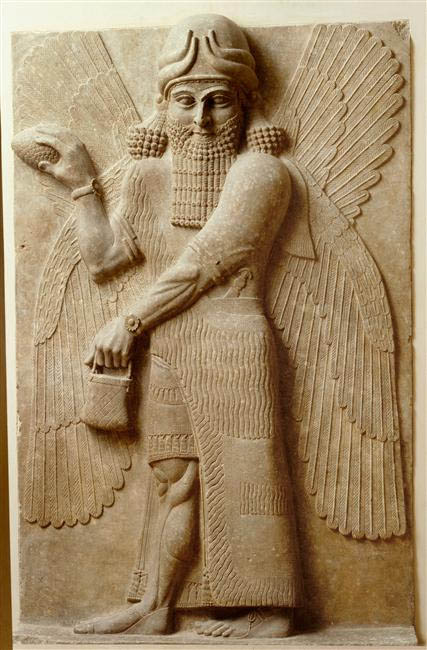 Technical information
Technical information Blessing genius Neo-Assyrian period, circa 721-705 BCE (reign of Sargon II)
Third gate of the palace of Sargon II, Khorsabad (ancient Dur-Sharrukin), Iraq
Bas-relief of gypseous alabaster
H. 4.09 m; L. 2.36 m; D. 0.75 m
Victor Place excavations, 1852-54
AO 19863
Near Eastern Antiquities [see: Musée du Louvre]
Blessing genius
Protective genii are supernatural beings who watch over humans or buildings and ward off evil spirits. This winged genius, along with one directly opposite, guarded the gates of the city of Khorsabad. It blessed all those who passed by it with water sprinkled from a pine cone.
Description
A protective and blessing genius
The site of Khorsabad (called Dur-Sharrukin in antiquity), which was excavated between 1843 and 1854 by Paul-Emile Botta and Victor Place, yielded orthostats, carved slabs of stone that protected and adorned the bases of brick walls. This monumental winged genius, represented frontally, was placed in the inner passage of one of the city gates. Another genius was located directly opposite. Both stood immediately behind the pair of winged bulls with human heads that guarded the gate. Like other genii placed at certain entrances to the palace, this one has a protective role. However it also performed a blessing function: from the pine cone, which could be shaken, liquid drawn from a little bucket was sprinkled over the passageway and those who passed along it.
A monumental sculpture
This colossal figure carved in high relief depicts a winged, bearded genius, shown frontally as far as the waist and in profile below. He holds a pine cone in his right hand and a small metal vessel (or situla) in his left hand. The face, framed by a curly beard, is surmounted by a tiara adorned with two pairs of horns. Over the figure's short tunic is a fringed cape, which covers the right shoulder and left leg. Two pairs of wings emerge from the back and spread symmetrically on either side of the body. His arms and forearms are adorned with rings and bracelets. He wears sandals, which cover his heels. On the base of this sculpture is a game of tick-tack-toe, scratched into it in ancient times, probably by sentries passing the time while on duty at the gate.
Genii: between the human and the divine?
Genii, depicted as bulls with human heads, men with birds' heads, and winged men, figure prominently in Assyrian mythology. They are creatures endowed with powers superior to those of human beings, yet they are not great deities, although they are sometimes represented with some of their attributes, for example, the horned tiara here. These supernatural beings had the power to ward off evil spirits. The genius seen here had an essentially protective role: it defended the gates and walls of the city. However, it was also a blessing genius, which held holy water and sprinkled it on visitors with a pine cone. Genii are often depicted in Assyrian art, especially in ceremonial scenes where they are shown pollinating the sacred palm tree. [see: Mesopotamia | Louvre Museum]
http://www.geocities.ws/leinad.trotta/prophecies.html

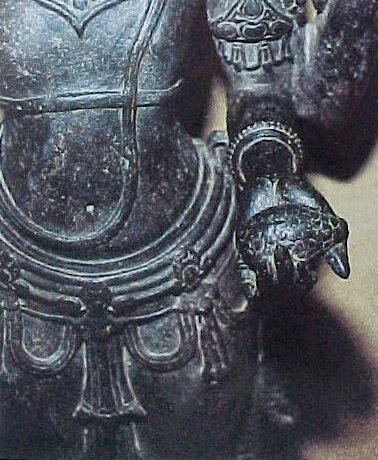
Somnathpur, Halebid. Lakshmi. Divinity of wealth holding maize cob or pine-cone.
Hieroglyphs: kandə ʻpineʼ, ‘ear of maize’. Rebus: kaṇḍa ‘tools, pots and pans of metal’. Rebus: kāḍ ‘stone’. Ga. (Oll.) kanḍ, (S.) kanḍu (pl. kanḍkil) stone (DEDR 1298).
Hieroglyph: Ash. piċ -- kandə ʻ pine ʼ, Kt. pṳ̄ċi, piċi, Wg. puċ, püċ (pṳ̄ċ -- kəŕ ʻ pine -- cone ʼ), Pr. wyoċ, Shum. lyēwič (lyē -- ?).(CDIAL 8407). Cf. Gk. peu/kh f. ʻ pine ʼ, Lith. pušìs, OPruss. peuse NTS xiii 229. The suffix –kande in the lexeme: Ash. piċ-- kandə ʻ pine ʼ may be cognate with the bulbous glyphic related to a mangrove root: Koḍ. kaṇḍe root-stock from which small roots grow; ila·ti kaṇḍe sweet potato (ila·ti England). Tu. kaṇḍe, gaḍḍè a bulbous root; Ta. kaṇṭal mangrove, Rhizophora mucronata; dichotomous mangrove, Kandelia rheedii. Ma. kaṇṭa bulbous root as of lotus, plantain; point where branches and bunches grow out of the stem of a palm; kaṇṭal what is bulb-like, half-ripe jackfruit and other green fruits; R. candel. (DEDR 1171). Rebus: kaṇḍa ‘tools, pots and pans of metal’.
Hieroglyph: కండె [ kaṇḍe ] kaṇḍe. [Telugu] n. A head or ear of millet or maize. జొన్నకంకి.
Rebus:Tu. kandůka, kandaka ditch, trench. Te. kandakamu id. Konḍa kanda trench made as a fireplace during weddings. Pe. kanda fire trench. Kui kanda small trench for fireplace. Malt. kandri a pit. (DEDR 1214).
[quote] Detail of pine cone. Standard Inscription.Palace of Ashurnasirpal, priest of Ashur, favorite of Enlil and Ninurta, beloved of Anu and Dagan, the weapon of the great gods, the mighty king, king of the world, king of Assyria; son of Tukulti-Ninurta, the great king, the mighty king, king of Assyria, the son of Adad-nirari, the great king, the mighty king of Assyria; the valiant man, who acts with the support of Ashur, his lord, and has no equal among the princes of the four quarters of the world; the wonderful shepherd who is not afraid of battle; the great flood which none can oppose; the king who makes those who are not subject to him submissive; who has subjugated all mankind; the mighty warrior who treads on the neck of his enemies, tramples down all foes, and shatters the forces of the proud; the king who acts with the support of the great gods, and whose hand has conquered all lands, who has subjugated all the mountains and received their tribute, taking hostages and establishing his power over all countries. [unquote]
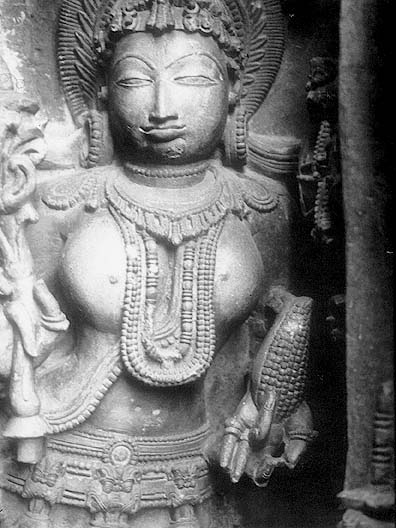 Halebid."Maize breeders in India, China, United States, and Great Britain, who have seen extensive collections of the illustrations, concur...only sculptors with abundant ears of maize as models could have created these illustrations of maize"(Click to enlarge). Photo by Carl L. Johannessen.
Halebid."Maize breeders in India, China, United States, and Great Britain, who have seen extensive collections of the illustrations, concur...only sculptors with abundant ears of maize as models could have created these illustrations of maize"(Click to enlarge). Photo by Carl L. Johannessen.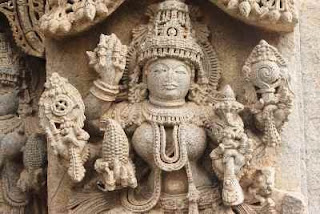
‘Maize’ and ‘pine-cone’ are two hieroglyphs depicted, respectively, on Indian sculptures at Somnathpur (Lakshmi, divinity of wealth) and on sculptures and reliefs of Ashur (Nimrud). Rebus readings are evidence of presence of Meluhha speakers in the Ancient Near East who participated in the bronze-age inventions of tin-bronzes and created the writing systems of deploying hieroglyphs together with cuneiform and Indus texts.
Hieroglyph: Ash. piċ -- kandə ʻ pine ʼ, Kt. pṳ̄ċi, piċi, Wg. puċ, püċ (pṳ̄ċ -- kəŕ ʻ pine -- cone ʼ), Pr. wyoċ, Shum. lyēwič (lyē -- ?).(CDIAL 8407). Cf. Gk. peu/kh f. ʻ pine ʼ, Lith. pušìs, OPruss. peuse NTS xiii 229. The suffix –kande in the lexeme: Ash. piċ-- kandə ʻ pine ʼ may be cognate with the bulbous glyphic related to a mangrove root: Koḍ. kaṇḍe root-stock from which small roots grow; ila·ti kaṇḍe sweet potato (ila·ti England). Tu. kaṇḍe, gaḍḍè a bulbous root; Ta. kaṇṭal mangrove, Rhizophora mucronata; dichotomous mangrove, Kandelia rheedii. Ma. kaṇṭa bulbous root as of lotus, plantain; point where branches and bunches grow out of the stem of a palm; kaṇṭal what is bulb-like, half-ripe jackfruit and other green fruits; R. candel. (DEDR 1171). Rebus: kaṇḍa ‘tools, pots and pans of metal’.
Hieroglyph: కండె [ kaṇḍe ] kaṇḍe. [Telugu] n. A head or ear of millet or maize. జొన్నకంకి.
 Allograph: Kur. kaṇḍō a stool. Malt. kanḍo stool, seat. (DEDR 1179). Rebus:Tu. kandůka, kandaka ditch, trench. Te. kandakamu id. Konḍa kanda trench made as a fireplace during weddings. Pe. kanda fire trench. Kui kanda small trench for fireplace. Malt. kandri a pit. (DEDR 1214).
Allograph: Kur. kaṇḍō a stool. Malt. kanḍo stool, seat. (DEDR 1179). Rebus:Tu. kandůka, kandaka ditch, trench. Te. kandakamu id. Konḍa kanda trench made as a fireplace during weddings. Pe. kanda fire trench. Kui kanda small trench for fireplace. Malt. kandri a pit. (DEDR 1214).[quote] Detail of pine cone. Standard Inscription.Palace of Ashurnasirpal, priest of Ashur, favorite of Enlil and Ninurta, beloved of Anu and Dagan, the weapon of the great gods, the mighty king, king of the world, king of Assyria; son of Tukulti-Ninurta, the great king, the mighty king, king of Assyria, the son of Adad-nirari, the great king, the mighty king of Assyria; the valiant man, who acts with the support of Ashur, his lord, and has no equal among the princes of the four quarters of the world; the wonderful shepherd who is not afraid of battle; the great flood which none can oppose; the king who makes those who are not subject to him submissive; who has subjugated all mankind; the mighty warrior who treads on the neck of his enemies, tramples down all foes, and shatters the forces of the proud; the king who acts with the support of the great gods, and whose hand has conquered all lands, who has subjugated all the mountains and received their tribute, taking hostages and establishing his power over all countries.
When Ashur, the lord who called me by my name and has made my kingdom great, entrusted his merciless weapon to my lordly arms, I overthrew the widespread troops of the land of Lullume in battle. With the assistance of Shamash and Adad, the gods who help me, I thundered like Adad the destroyer over the troops of the Nairi lands, Habhi, Shubaru, and Nirib. I am the king who had brought into submission at his feet the lands from beyond the Tigris to Mount Lebanon and the Great Sea [the Mediterranean], the whole of the land of Laqe, the land of Suhi as far as Rapiqu, and whose hand has conquered from the source of the river Subnat to the land of Urartu.
The area from the mountain passes of Kirruri to the land of Gilzanu, from beyond the Lower Zab to the city of Til-Bari which is north of the land of Zaban, from the city of Til-sha-abtani to Til-sha-Zabdani, Hirimu and Harutu, fortresses of the land of Karduniash [Babylonia], I have restored to the borders of my land. From the mountain passes of Babite to the land of Hashmar I have counted the inhabitants as peoples of my land. Over the lands which I have subjugated I have appointed my governors, and they do obeisance.
I am Ashurnasirpal, the celebrated prince, who reveres the great gods, the fierce dragon, conqueror of the cities and mountains to their furthest extent, king of rulers who has tamed the stiff-necked peoples, who is crowned with splendor, who is not afraid of battle, the merciless champion who shakes resistance, the glorious king, the shepherd, the protection of the whole world, the king, the word of whose mouth destroys mountains and seas, who by his lordly attack has forced fierce and merciless kings from the rising to the setting sun to acknowledge one rule.
The former city of Kalhu [Nimrud], which Shalmaneser king of Assyria, a prince who preceded me, had built, that city had fallen into ruins and lay deserted. That city I built anew, I took the peoples whom my hand had conquered from the lands which I subjugated, from the land of Suhi, from the land of Laqe, from the city of Sirqu on the other side of the Euphrates, from the furthest extent of the land of Zamua, from Bit-Adini and the land of Hatte, and from Lubarna, king of the land of Patina, and made them settle there.
I removed the ancient mound and dug down to the water level. I sank the foundations 120 brick courses deep. A palace with halls of cedar, cypress, juniper, box-wood, meskannu-wood, terebinth and tamarisk, I founded as my royal residence for my lordly pleasure for ever.
Creatures of the mountains and seas I fashioned in white limestone and alabaster, and set them up at its gates. I adorned it, and made it glorious, and set ornamental knobs of bronze all around it. I fixed doors of cedar, cypress, juniper and meskannu-wood in its gates. I took in great quantities, and placed there, silver, gold, tin, bronze and iron, booty taken by my hands from the lands which I had conquered. [unquote]
New York city Art museum. Ashurnasirpal. Kalhu Ear-ring and pendant with a pine cone glyph
 Pine cone glyphs adorn the side stools and is atop the ‘altars’ or ‘standards’. [quote]Description: The 'Garden Party' relief from the North Palace of Ashurbanipal at Nineveh. This carved stone picture hides a gory secret. King Ashurbanipal and his Queen are enjoying a party in their garden. Can you see the Queen sitting down facing her husband? A harpist on the left plays music while they eat and drink. But in the tree beside him is the severed head of King Teumann, a local ruler who had tried to fight against Ashurbanipal. The picture was on the wall in the royal palace, to warn any visitors not to try the same thing. It should also be noted that depictions of women are rare in Assyrian art. (Source: British Museum website) Date: c.645 BCE [unquote]
Pine cone glyphs adorn the side stools and is atop the ‘altars’ or ‘standards’. [quote]Description: The 'Garden Party' relief from the North Palace of Ashurbanipal at Nineveh. This carved stone picture hides a gory secret. King Ashurbanipal and his Queen are enjoying a party in their garden. Can you see the Queen sitting down facing her husband? A harpist on the left plays music while they eat and drink. But in the tree beside him is the severed head of King Teumann, a local ruler who had tried to fight against Ashurbanipal. The picture was on the wall in the royal palace, to warn any visitors not to try the same thing. It should also be noted that depictions of women are rare in Assyrian art. (Source: British Museum website) Date: c.645 BCE [unquote]Assyrian Period, reign of King Ashurnasirpal 11 (883 -- 859 BCE) Alabastrous Limestone Height 110.5 cm. Width 183 cm. Depth 6.4 -- 9.6 cm. Miho Museum http://www.shumei.org/art/miho/miho.html
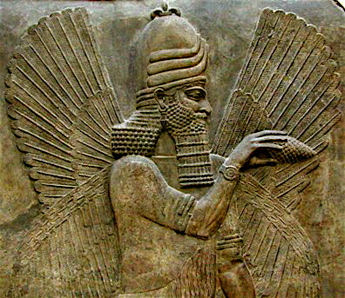 Marduk, winged, holding the pine-cone. Bracelet has safflower hieroglyph. Annunaki, Sumerian.
Marduk, winged, holding the pine-cone. Bracelet has safflower hieroglyph. Annunaki, Sumerian.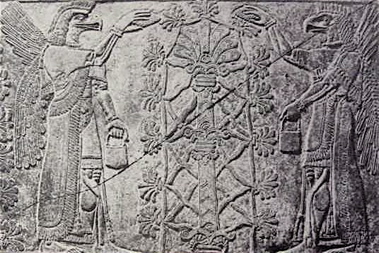 Pine cones helod by eagle-divinities flanking tree of life. The divinities also hold wallets.
Pine cones helod by eagle-divinities flanking tree of life. The divinities also hold wallets.Masonic cadueceus with pine cone.
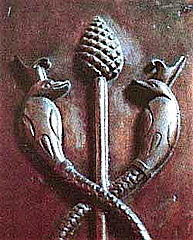 A pair of eagle-headed Annunak flanking a staff capped with a pine-cone.
A pair of eagle-headed Annunak flanking a staff capped with a pine-cone.Assyrian) alabaster Height: 236.2 cm (93 in). Width: 135.9 cm (53.5 in). Depth: 15.2 cm (6 in). This relief decorated the interior wall of the northwest palace of King Ashurnasirpal II at Nimrud. On his right hand, he holds a pine cone. Examples of reliefs of king ashur-nasir-pal II
The Egyptian Staff of Osiris, dating back to approximately 1224 BC, depicts two intertwining serpents rising up to meet at a pinecone. (Photo: Egyptian Museum, Turin, Italy)
Annex A Temple of Isis from which the bronze pine cone was brought to the Vatican
https://sites.google.com/site/ad79eruption/pompeii/public-buildings/temple-of-isis
Temple of Isis
|







